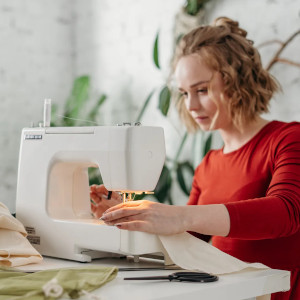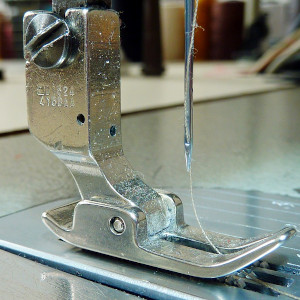 The craze for sewing and has been increasing day by day. People have started taking up sewing lessons either through online courses or from training centers. There has been an exponential growth in the fashion industry, whose foundation lies in knowing the basic skills of sewing. Along with all the necessary lessons to excel in this field, one of the most important sectors which are still underrated is the safety methods.
The craze for sewing and has been increasing day by day. People have started taking up sewing lessons either through online courses or from training centers. There has been an exponential growth in the fashion industry, whose foundation lies in knowing the basic skills of sewing. Along with all the necessary lessons to excel in this field, one of the most important sectors which are still underrated is the safety methods.
Be it a beginner or a sewing expert; it is already clear that one must know how to operate a sewing machine. But one must not overlook the precautionary steps to avoid accidents. Most of the unfortunate incidents in this field are related to the sewing machine. Any diversion from the device may cause injury. Although private sewers must follow safety measures, it is also necessary for people working in manufacturing industries. Mechanical and computerized machines are much more prone to danger and risks, if not paid attention.
Things To Remember About
Below mentioned are some of the sewing machine safety measures that the user must follow and keep a check.
Electric Connection
For those who use electrical and computerized sewing machines, the essential requirement is electricity. These machines do not work without it. Human resources involvement is only when the machine is in running condition. Thus, every worker must be aware that the flow of electric current to the device is safe and sound.
Most accidents in manufacturing and garment industries occur due to short circuit. For instance: fire and electrocution. Daily checking of the main power supply is a must. In the mass production of garments, factories must have a regular inspection of every power board in and around the region.
 Plugs and Sockets
Plugs and Sockets
For small scale industries or domestic users of the electric sewing machine, one must be aware of the switchboard panel that connects the cord of the device.
Double-check if the Plugging-in is secure. In case, it is loose, shift to another power board.
Likewise, after every use, assure that you have plug-out the cord from the board.
If there is the usage of extension boards, make sure that they are a good quality one.
A cheaper one may not be able to take the continuous flow of electricity through it.
Cords
Once you ensure that an optimum amount of electricity passes through the circuit boards to the sewing machine, one should also look into the wires before connecting it to power. Even if a minute cut or wearing off is visible in any of the machine cords, replace it immediately. If you are aware and confident about repairing, you may do it personally. If not, ask for the help of an electrician or a professional from the machine brand. Use it only after its repair.
Physical Safety
 To ensure that no worker or user is injured while working, along with precautionary measures by the industries and other work stations, personal care is also necessary.
To ensure that no worker or user is injured while working, along with precautionary measures by the industries and other work stations, personal care is also necessary.
Women must tie their hair properly. Loose strands of hair may get stuck in the machine while working on intricate details.
Let your fingers maintain a certain distance while inserting the fabric in the feeder while sewing through them. There is a risk of injury from the needle’s work in progress to the user’s hand and fingers.
Please ensure the power supply; it must be in switch-off mode until you are entirely ready to sew.
Concentrate while using the handwheel as well in manual sewing machines.
Do not get too close to the machine. A breakage in the needle or a button may pop up and enter the eyes. Since eyes are quite delicate, it is a good idea to maintain a minimum distance from the machine. People using spectacles are not at mush risk in this situation. But others may use protective eye gear to be on a safer side.
Training
People who use their machine knows well how to operate them. But those who are new to a different kind of device must first know how to work with it. With proper training, one must start working. They will surely hurt themselves if there is no provision of training. Beginners are most likely to be injured than an experienced one. In-depth knowledge about the procedure of working with a sewing machine will minimize the hazard.
Settings
Before you begin to sew, confirm that all the settings are in place, especially for electric sewing machines. A separate settings button is available on the device. Set it accordingly before sewing as per the fabric’s requirement.
Speed
Maintain the speed of operation while stitching in a sewing machine.
Too slow speed will, of course, lower productivity. Likewise, very high speed may cause accidents as well.
An average speed of the machine will help to balance both the issues.
Regulate the speed of presser foot in the sewing machines as well.
Maintenance of Machine
 To reduce sewing machine hazards, regular maintenance before and after sewing is also necessary.
To reduce sewing machine hazards, regular maintenance before and after sewing is also necessary.
Keep the thread length longer while starting to avoid entangling.
Keep the presser foot in a downward position before starting to sew and after completing as well.
Use a cutter or seam ripper to cut threads instead of using bare hands.
Annual maintenance of the machine is a must for sewing machine safety and longevity.
Regular cleaning and oiling will keep the machine in working condition.
Check for any anomaly in the machine and ask for help or use the quick-fix ideas known to you.
Sewing Machine Safety: Final Thoughts
Along with an excellent output of the finished product of the sewing project, one must also be aware to avoid injury. The occurrence of accidents is due to a lack of concentration. Working on multiple projects simultaneously will also divide the attention and may pose a considerable risk. Following the safety tips mentioned above shall minimize the risk. Both productivity and safety complement each other. To achieve a fantastic sewing experience, along with operational procedures, knowledge, and practice, ensure to follow the safety tips too.


